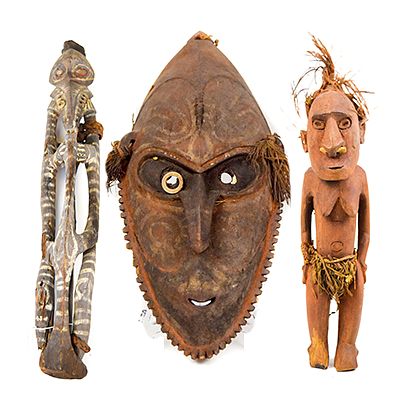Kakar Spear
Two ways to bid:
- Leave a max absentee bid and the platform will bid on your behalf up to your maximum bid during the live auction.
- Bid live during the auction and your bids will be submitted real-time to the auctioneer.
Bid Increments
| Price | Bid Increment |
|---|---|
| $0 | $10 |
| $100 | $25 |
| $500 | $50 |
| $1,000 | $100 |
| $2,500 | $250 |
| $5,000 | $500 |
| $10,000 | $1,000 |
| $25,000 | $2,500 |
| $50,000 | $5,000 |
| $100,000 | $10,000 |
About Auction
Nov 16, 2021
Adventurer, Academic, Industrialist: Louis Pierre Ledoux 1936 New Guinea Expedition In early 1936, on recommendation by American anthropologist Margaret Mead, Louis Pierre Ledoux, headed to the lower eastern Sepik River of Papua New Guinea to study the Murik people. Willow Auction House jill@willowauctionhouse.com
- Lot Description
Kakar spear, with rattan and rope band, face of ancestor figure. Kakar spears are some of the most sacred and important features of Murik society, as they are thought to possess spiritual powers to aid in (former) headhunting raids. The Kakar spears themselves embody ancestor spirits themselves.
Referring to Ledoux while explaining how some missionaries were overzealous in eradicating the headhunting and other rituals, and their associated tools, including spears, David Lipset (1997) explains “In one village (Kaup), he [the over zealous missionary] took it upon himself to break the Kakar spears over his knee. Father Schmidt [an empathic missionary] dutifully stored the pieces in the attic of his house until 1936 when he gave them to a young American ethnographer, Pierre Ledoux, who was doing research in the Murik Lakes.”
Source:
LIPSET, David. Mangrove Man: Dialogic of Culture in the Sepik Estuary, Cambridge: University of Cambridge Press, page 196.Ledoux's list of Collection Items (lot 108 box E), corroborates Lipset's account.
Similar item gifted by Ledoux in 1936 to the American Museum of Natural History - Division of Anthropology (80/9075).
Locale: Murik Lakes, Lower Sepik River
Country: Papua New Guinea
Date: 1936 or earlier
Material: Wood, rattan, rope
Technique: Carved
Dimensions: H 63" x W 3"Provenance: Louis Pierre Ledoux Collection
Similar item:
American Museum of Natural History - Division of Anthropology (80/9075)
https://anthro.amnh.org/anthropology/databases/common/image_dup.cfm?catno=80%2E0%2F%209075 - Buyer's Premium



 EUR
EUR CAD
CAD AUD
AUD GBP
GBP MXN
MXN HKD
HKD CNY
CNY MYR
MYR SEK
SEK SGD
SGD CHF
CHF THB
THB















